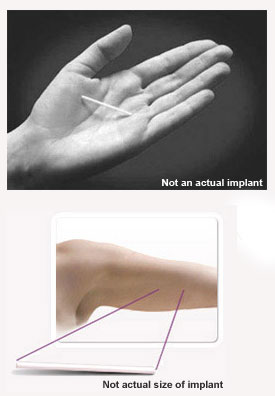 Implanon is a form of sub-dermal birth control made by Merck & Co. It’s a match stick-sized device that is placed under the skin in a fat layer of the upper arm. It’s a progestin-only method and provides about 3 years of pregnancy protection by preventing ovulation. Insertion requires a local anesthetic and only takes a few minutes. It’s a fairly simple procedure, and the implant can be taken out at any time. However, it must be implanted, and taken out, by a doctor.
Implanon is a form of sub-dermal birth control made by Merck & Co. It’s a match stick-sized device that is placed under the skin in a fat layer of the upper arm. It’s a progestin-only method and provides about 3 years of pregnancy protection by preventing ovulation. Insertion requires a local anesthetic and only takes a few minutes. It’s a fairly simple procedure, and the implant can be taken out at any time. However, it must be implanted, and taken out, by a doctor.
How it Works
Implanon continually releases a low dose of etonogestrel (a progestin) to protect against pregnancy for up to 3 years. It contains 68 milligrams of etonogestrel, released over the 3-year period; about 60 to 70 micrograms per day are released in the first year, and the amount decreases over time. After the third year, Implanon will still release some hormone, but it will not be enough to prevent pregnancy.
Advantages
• Works for up to 3 years (4 years off-label)
• Most effective form of birth control
• Does not contain estrogen
• Works quickly after insertion
• Nothing to do right before sex to make it work
• Fertility returns quickly after removal
• 20% women have no more periods while using
Disadvantages
• Irregular menstrual bleeding or spotting
• Pain or scarring at insertion site
• Possible small increase in weight
• Headache, acne, ovarian cysts, or change in mood can possibly occur
Apart from the irregular bleeding, the most frequent side effects causing women to stop using Implanon include mood swings, weight gain, breast tenderness, headache, acne, and depression.
In addition, there are side effects reported by women using Implanon, which includes the following:
• Dizziness
• Vaginitis
• Stomach pain
• Hair loss
• Painful periods
• Nervousness
• Back pain
• Nausea
• Pain at insertion site
• Viral infections (colds, sore throats, sinus infections, or flu-like symptoms)
• Rare side effects that have also been reported include: extra hair on the face and body, trouble using contact lenses, and spotty darkening of the skin, especially on the face.
Who Can Use Implanon?
This is a safe birth control option for most healthy women. It is important to discuss your full medical history with your doctor before using the implant.
Some women could still use Implanon even with certain risk factors as long as they remain under close medical supervision. But Implanon may not be the right method for everyone.
Implanon use is not recommended if you:
• Are pregnant or think you may be pregnant
• Have or have had breast cancer
• Have unexplained vaginal bleeding
• Have liver disease
• Have a history of severe depression
• Have or had serious blood clots: in your legs (deep venous thrombosis), lungs (pulmonary embolism), eyes (retinal thrombosis), heart (heart attack), or head (stroke)
Additionally, discuss with your doctor about the use of Implanon if you have or had diabetes, high cholesterol or triglycerides, headaches, seizures/epilepsy, gallbladder or kidney disease, high blood pressure, or an allergic reaction to anesthetics or antiseptics.
Effectiveness
Implanon is 99.9% effective. This means that out of every 100 women who use Implanon in one year, less than 1 will become pregnant with typical use as well as with perfect use. Implanon may be less effective in women who are overweight as the progestin serum levels are inversely related to body weight.
Fertility After Removal
Within a week of removal, the hormones from the device leave the body and etonogestrel is undetectable in most users. Most women will begin to ovulate within six weeks of removal. Fertility levels will return to what they were before Implanon insertion.
(References : Nexplanon/Implanon at Wikipedia – Implanon USA official site)



 Saving...
Saving...